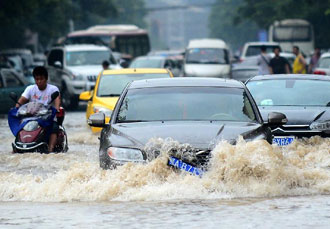China hopes to expand its cloud seeding system to produce more artificial rain than the 50 billion tons produced last year, according to a report submitted to China’s top legislature Monday.
China already has far and away the world’s biggest weather modification system. It is used to end severe droughts or prevent floods, defuse potential crop-damaging hailstorms or even just to keep major events like the 2008 Olympics from being hampered by rain or severe smog.
Rather than seeding clouds by flying airplanes equipped with devices to disperse silver iodide or dry ice, China’s rainmakers prefer to fire silver iodide rockets into cloud banks, occasionally with spectacular success. In February of 2009 the system was used to end a four-month drought in Beijing by inducing snow. The resulting 3-day snowfall was heavy enough to close many of the city’s roads for days.
Cloud seeding was even used prior to the 2008 Beijing Olympics in an attempt to help clear away the heavy smog that often envelopes the city. While the effectiveness of cloud-seeding is often disputed, the city did enjoy a modest respite from heavy smog during some days of the two-week event.
Regardless of the precise degree of credit due to the nation’s cloud-seeding system, it is seen as a source of hope for the millions of Chinese suffering from one weather condition or another at any given time. That’s ample justification for the State Council to promote the nation’s extensive weather modification system and tout its benefits.
A total of 2,266 counties in China use weather modification programs. The main components are artificial rainmaking efforts covering about 5 million square kilometers, or about half of the nation’s land area, according to the report detailing implementation of China’s meteorological law presented to the bi-monthly session of the Standing Committee of the National People’s Congress.
China has also established a system of seven geosynchronous and sun-synchronous satellites to monitor weather of which five are currently in working condition. But the system is deemed inadequate to meet demands for disaster prevention and relief, especially in grassroots and rural areas, according to the report.
The report urged improvement in the accuracy of weather forecasts and to boost efforts at using artificial weather and disaster prevention more effectively.
The extensive use of cloud seeding often creates tensions between neighboring regions accusing one another of “stealing rain”.
Cloud seeding is also used in the US, though on a more ad hoc and private level than in China. Eleven western states have implemented weather modification programs to ease the impact of droughts and hailstorms. One of the biggest is an $8.8 million project in Wyoming to examine the effects of cloud seeding on snowfall over Wyoming’s Medicine Bow, Sierra Madre, and Wind River mountain ranges.
Various US firms offer weather modification services through cloud seeding. Some major US ski resorts also use it to induce snowfall. However, in most nations of the world national governments have resisted instituting formal weather modification programs on the level of China’s due to questions about the value and effectiveness of such efforts.


